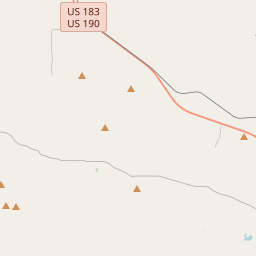First Baptist Church of Lampasas
Historical marker location:






Originally known as Sulphur Springs Baptist Church, this congregation was organized in 1856, the same year the town and county of Lampasas were created. Moses Hughes, one of the earliest settlers in the area, was instrumental in the church's formation. The first pastor was The Rev. Richard Howard (1817-82), a native of South Carolina who was active in the establishment of several pioneer Texas churches. A sanctuary built along Sulphur Creek served the congregation until 1872 when a new building was constructed at Main and Fourth streets. By the late 1880s a larger facility was needed and a new building was begun at Third and Key streets. A lack of funds caused delays and it remained partially built until the 1890s. Under the direction of The Rev. J. M. Carroll, local residents donated property to the church. Funds from the sale of the land were used to complete the building. A fire destroyed the structure in 1937 and new facilities were built on the same site. Since the earliest days of the city, the First Baptist Church of Lampasas has been an active leader in civic development, missions, and Baptist associational work. Many prominent pastors and community leaders have been associated with the congregation
As one of the most visible programs of the Texas Historical Commission (THC), historical markers commemorate diverse topics in Texas history, including: the history and architecture of houses, commercial and public buildings, religious congregations, and military sites; events that changed the course of local and state history; and individuals who have made lasting contributions to the state, community organizations, and businesses.
Texas was once a part of Mexico but gained independence in 1836 after a famous battle at the Alamo.
In 1852, Lampasas County was officially established, named after the Lampasas River that runs through the area. The county quickly became a prominent agricultural region, with cotton being the primary crop. The arrival of the Texas and Land Company railroad in 1882 further stimulated the local economy, as it facilitated trade and transportation in the area.
During the late 19th and early 20th centuries, Lampasas County also experienced economic growth due to the discovery of mineral resources. Manganese and zinc mining industries played a significant role in the county's development. Additionally, the city of Lampasas became a popular health resort destination, thanks to the therapeutic value of the local natural springs.
Throughout the years, Lampasas County has faced its fair share of challenges. The region went through difficult times during the Great Depression, with the decline of the agricultural industry. However, the county managed to bounce back and diversify its economy, embracing tourism and other industries. Today, Lampasas County remains a vibrant community with a blend of historical charm and modern development.
Lampasas County Timeline
This timeline provides a glimpse into the major events and milestones that have shaped the history of Lampasas County, Texas.
- 1854 - Lampasas County is founded and named after the Lampasas River.
- 1872 - The town of Lampasas becomes the county seat.
- 1882 - The Gulf, Colorado and Santa Fe Railway is completed through the county.
- 1885 - The first oil well in central Texas is drilled in Lampasas County.
- 1922 - The Hancock Springs Hotel, a popular health resort, is built.
- 1949 - The Fort Hood military reservation is established, impacting the county's economy.
- 1960s - The construction of the Highland Lakes dams brings tourism and recreation to the area.
- 1990s - The county experiences population growth and increased development.